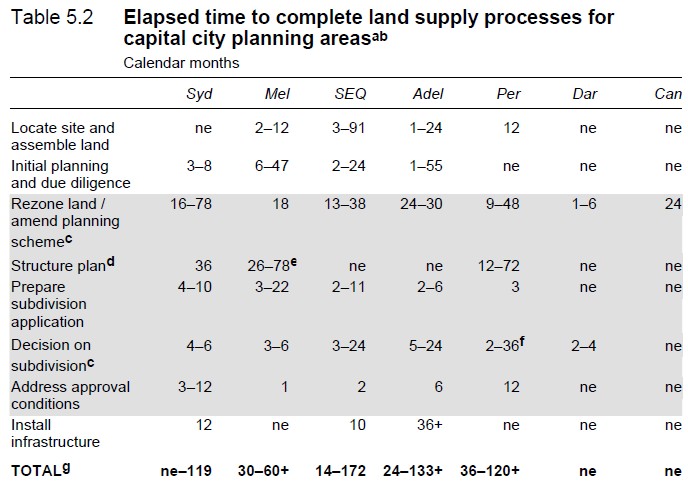
In April last year, the New South Wales Government released its Planning White Paper, which attempted to “make NSW more competitive by improving decision making, providing more certainty and making it more cost effective to do business in the state”, by streamlining decision-making processes amongst NSW’s 152 local councils.
Under the White Paper, councils were to be required to give approval to 80% of all complying buildings within 25 days, with approvals on straight forward applications (i.e. where new homes and renovations are under two storeys and do not affect neighbours with overshadowing or privacy issues) required in under 10 days.
In releasing the White Paper, the New South Wales Government was attempting to eschew the former government’s meme that “Sydney is full” in favour of greater openness to urban growth, in light of ongoing population pressures.
In addition to the planning changes, the Government announced that it would establish a $561 million fund to pay for road and sewerage infrastructure in new housing estates, with the explicit aim of stimulating housing supply in order to cater for Sydney’s growing population.
The Government also announced an ambitious plan to speed-up the supply of 172,000 new homes across Sydney, most of which will be on greenfield sites, along with reforms to infrastructure charges on new housing, in a bid to lower development costs, improve housing affordability, and increase fairness.
On the face of it, the NSW Government’s proposed housing reforms were positive.
New South Wales’ planning system is regarded by many as the country’s poorest performing, and in most need of fundamental reform. In its 2011 planning report, the Productivity Commission noted that it took up to 119 months (nearly 10 years) to complete land supply processes in Sydney, with much of this time consumed by rezoning (see next table).

The Government’s proposed requirement that councils properly deliver on the infrastructure in which they have levied was a no brainer, as was cutting back council’s rights to extort extra funding in exchange for development approval (arguably a form of tacit corruption). The ‘doctrine of contestability’ enshrined in the proposal, whereby developers would be permitted to build and own infrastructure (presumably funded by rates on home owners), also looked like a shift towards the Texas model, which has been highly successful if providing affordable housing to Texas’ fast growing population.
I have written previously how BANANAs (“Build Absolutely Nothing Anywhere Near Anything”) are becoming a growing feature of Australia’s urban landscape. They typically comprise people that bought their homes many years on the cheap (helped by governments that were amenable to development) decrying both “evil sprawl” and high-rise development.
The BANANA fraternity, which includes many urban planners, seem to believe in mutually exclusive thinking: that somehow Australia’s capital cities can continue to accommodate increased population without growing the urban footprint and/or higher density.
Unfortunately, the housing BANANAs continue to win the battle against New South Wales’ sensible housing reforms.
In October last year, the AFR reported that intense lobbying from BANANAs and NIMBYs had provoked a back down from the New South Government, with Planning Minister, Brad Hazzard, introducing the new planning bill into Parliament, which slashed the 80% code assessment target and reduced its application to areas considered “high density”, namely concentrated around railway corridors.
And on Friday, it was revealed in The SMH that Labor and the Greens are hard at work attempting to scuttle the reforms:
The overhaul of the state’s planning laws – touted as the biggest reform in 30 years – has been in limbo since last November after Labor, the Greens and the Shooters and Fishers Party voted together to make major amendments…
Department officials and business and community groups have been in talks with crossbench MPs over the bill for the past three months, but have failed to break the stalemate…
[Planning Minister, Brad Hazzard]… accused Labor of opposing the reforms to win “a handful of Green votes”, saying the party “walked away from NSW families desperate for housing, infrastructure and jobs”…
It is understood he will continue to push the beleaguered bill, despite opposing sides appearing unwilling to concede ground…
Business groups, including the Committee for Sydney, have also made direct approached to MPs to lobby for the reforms.
The committee’s chief executive Tim Williams said: “We are strong supporters of community engagement but also of a more efficient development applications process. We believe that the majority of Sydneysiders want planning reform but a noisy minority is preventing [it].”
Any backsliding on reforms to planning and land-use is likely to place further upward pressure on urban land values across Sydney and beyond, reducing housing affordability (despite shrinking home sizes) and worsening congestion. While those lucky enough to be pre-existing land holders will benefit from the rising wealth brought about by higher values, lower income households and those yet to enter the market (including future generations) will suffer, as will the overall competitiveness of the New South Wales economy as escalating land costs feed into the costs of production.
Once again, rent seekers are proving successful in formulating policy to the detriment of the broader interest.

